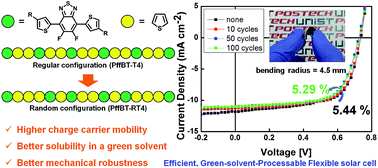A donor–acceptor semiconducting polymer with a random configuration for efficient, green-solvent-processable flexible solar cells†
Abstract
Morphologies and optoelectronic/mechanical properties of semiconducting polymers are significantly affected by their configurations. In this study, thiophene units are introduced into the backbone of a semiconducting polymer in either a regular (PffBT-T4) or a random (PffBT-RT4) manner to determine whether the resulting semiconducting polymers are suitable for developing efficient polymer solar cells. The energy levels of both polymers are highly similar because they share the same ratio of subunits in their backbones; however, PffBT-RT4 has lower crystallinity than PffBT-T4 due to its random configuration. Microstructural analyses indicate that PffBT-RT4 exhibits a shorter π–π stacking distance than PffBT-T4. Since short π–π stacking distance benefits interchain charge transport, PffBT-RT4 shows higher space-charge-limited current mobility, and PffBT-RT4 solar cells exhibit higher power conversion efficiency (PCE; 8.84%) than their PffBT-T4 counterparts (7.25%). In addition, PffBT-RT4 solar cells with active layers, prepared using a green solvent without any additive, show an encouraging PCE of 7.23%. Moreover, flexible solar cells based on PffBT-RT4 are much more stable during bending cycles than PffBT-T4 flexible solar cells. Therefore, this study demonstrates that the random configuration approach is a promising design strategy to realize semiconducting polymers for efficient, green-solvent-processable flexible polymer solar cells.

- This article is part of the themed collection: 2018 Journal of Materials Chemistry A HOT Papers


 Please wait while we load your content...
Please wait while we load your content...